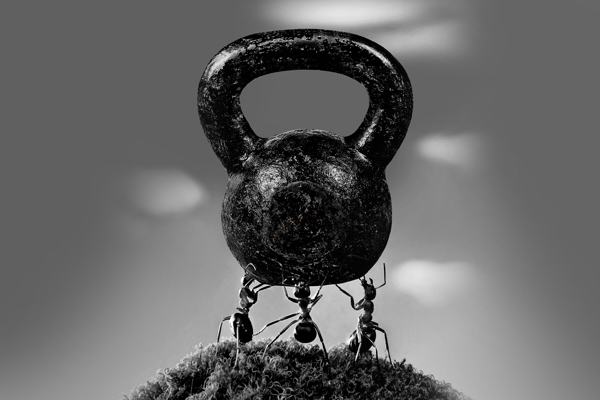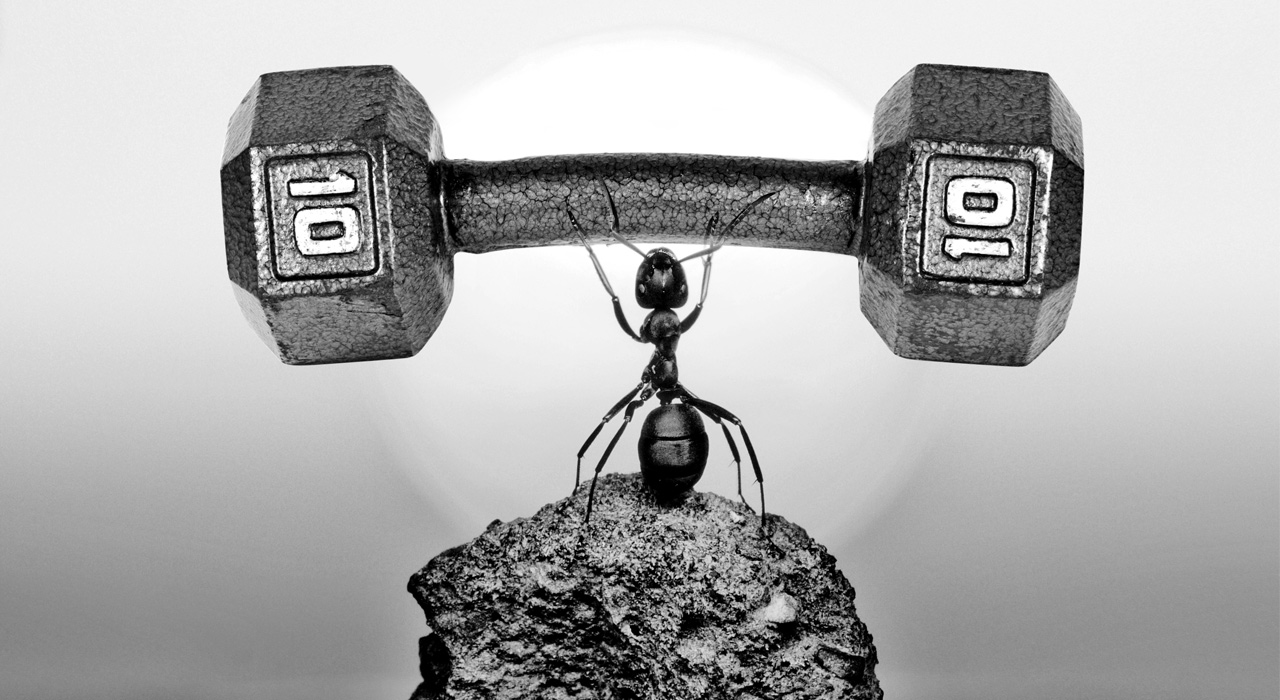There’s something savage about a man’s desire to be stronger than the next guy. Here’s how to embrace those desires with 20 ways to double your strength and to make sure you’re always upping your numbers.
An ant can lift up to 50 times its bodyweight; a rhinoceros beetle can haul a massive 850 times its own mass.
As humans, we’re nowhere near reaching these dizzying feats of strength, but we can separate ourselves from the rest of our species by making small strength gains every week that’ll amount to a gargantuan overall improvement in power. Here’s how…
1. Genetics – choose parents or patience
The uncomfortable truth is that you’ll either be born gifted with a body that plays well with strength training or not.
Everyone can improve strength but some will do it at a far faster rate than others, all other things being equal.
“The thing that people, especially other people in my position, don’t want to come to terms with is that innate genetic factors are hugely important,” says elite level powerlifter, Greg Nuckols. “I wanted to believe I was the strongest because I was so smart and worked so hard. Nonsense.”
The thing to remember is that you will get stronger but, like anything that’s worthwhile, gaining strength is a lifetime endeavour – don’t feel discouraged if your progress isn’t as fast as the next man.
You’ll absolutely get stronger with perseverance. It’s you vs you.
2. Focus on the exercises that’ll double your strength
Some exercises generally lend themselves to you being able to lift twice your bodyweight in them.
The below is a general list for the person starting out with the goal of lifting twice their bodyweight.
If you want to argue that the exercises in the “No” section, are also suitable for lifting double your bodyweight, I want to apologise to you right now…I’m obviously talking to the Incredible Hulk.
Exercises to aim for a double bodyweight lift:
Yes – Bench press, squats, deadlifts, weighted pull-ups, hip thrusts, rack pulls, dips.
No – Overhead press (possible but insane strength required), single-joint exercises (bicep curls, flyes, etc).
3. The strength numbers you should be looking at achieving
Because of individual genetics, you’ll find that it’s hard to tell how much anybody should be lifting in order to be considered strong. Of course, that hasn’t stopped guidelines from appearing…
Bench press
Average: 1x bodyweight
Above average: 1.5x bodyweight
Elite: 2X bodyweight
Barbell back squats
Average: 1.5x bodyweight
Above average: 1.75x bodyweight
Elite: 2.5x bodyweight
Deadlifts
Average: 1.5x bodyweight
Above average: 2x bodyweight
Elite: 2.75x bodyweight
These are your goals – write them down then watch videos online of people smashing them and stoke the fire inside.
4. Use Jim Wendlers 5/3/1 strength routine
Starting with less will equal more. Jim Wendler’s 5/3/1 strength routine has become one of the most popular for it’s simplicity and effectiveness.
It’s a four-week strategy where you train three days a week. Each day you train one of the big three exercises: bench press, squat or deadlift in the format below.
Every third week you test your new one repetition maximum which should have increased before taking a de-load on week four and then starting the training cycle again. It really is that simple.
You may add minimal accessory work, bodybuilding or train your weaknesses after you’ve completed the main lift but a maximum of one or two exercises.
You may feel like the Wendler 5/3/1 routine is too minimal but Jim squats over a 1000lb, so you’re probably wrong.
| WENDLER 5/3/1 | WEEK 1 | WEEK 2 | WEEK 3 | WEEK 4 |
|---|---|---|---|---|
| Set 1 | 65% x 5 | 70% x 3 | 75% x 5 | 40% x 5 |
| Set 2 | 75% x 5 | 80% x 3 | 85% x 3 | 50% x 5 |
| Set 3 | 85% x 5+ | 90% x 3+ | 95% x 1+ | 60% x 5 |
5. Want a stronger squat? Then squat
On the contrary, Olympic weightlifting coach, John Broz, has a now infamous, if slightly disturbing rhetorical question for aspiring strength athletes.
“If your family were captured and you had to put 100lb on your squat in the next month or you’d never see them again, would you squat once per week?”
Training frequency develops neural adaptation. Simply put, training a movement more often will mean you’ll get better at it, faster.
Pick one of the strength exercises you’re weakest in and work on turning it into your strength by hitting it at least 2-4 x per week.

6. Train for power
Pick either the squat or the bench press and train it four days a week using this killer Smolov Jr routine.
This will put some hairs on your chest as well as some extra plates on either side of your bar.
| SMOLOV Jr | WEEK 1 | WEEK 2 | WEEK 3 |
|---|---|---|---|
| Day 1 | 6 x 6 @ 70% of 1RM | 70% + 5-10lbs | 70% + 10-20lbs |
| Day 2 | 7 x 5 @ 75% of 1RM | 75% + 5-10lbs | 75% + 10-20lbs |
| Day 3 | 8 x 4 @ 80% of 1RM | 80% + 5-10lbs | 80% + 10-20lbs |
% are of your one rep max
7. The power of tapering off
Of course, a time will come when you want to test whether your training has resulted in some newfound strength but you shouldn’t jump straight in after an intense week of training.
A well-timed taper can increase performance from between 1-6% according to the Journal of Science and Sports.
Not quite the same as a de-load week where the idea isn’t to peak for an event or strength test, but to taper your workouts appropriately
8. Taper down for a BIG lift
The idea behind the taper is to reduce fatigue and maintain your fitness in order to be prepared to test your new one rep max.
Cutting back on volume (sets) does the most to facilitate recovery but you’ll want to maintain intensity in order to keep your newfound strength for the big day.
Here’s an example three-day taper week – remember, absolutely no extra accessory this week:
Exercise %1RM Sets Reps
Day 1: Squats 95 2 1-2
Day 2: Deadlifts 80 2-3 2-3
Day 3: Bench press 95 2 1-2
Rest
Day 4: 1RM Test Day
9. Warming up for your new record
The day you’ve been working so hard for has arrived. It’s time to see whether you’ve added that extra strength we all crave.
Don’t rush it – ensure that your joints are warm, mobile and be sure you’re lifting the bar as explosively as possible in every set, even if you feel stupid pushing 30% of your normal weight at warp speed. Here’s what a 1RM test might look like:
% of 1RM Reps Rest
Set 1 30-50% 8 2 minutes
Set 2 60% 5 2 minutes
Set 3 70% 3 3 minutes
Set 4 80% 2 3 minutes
Set 5 90% 1 5 minutes
Set 6 100% 1 5+ minutes
Set 7 (PB attempt) +2-5% 1 5+ minutes
Note: Repeat any warm up sets until you feel ready for new personal record attempt.
10. Turning weaknesses into strengths
Weaknesses in certain areas? Some key accessory exercises can bring them up to speed:
Squats
Box squats – People tend to be weak out of the hole so set up the box below parallel, lower until you’re sat on the box, pause and explode up.
Strengthening your lower back with hyper extentions and/or good mornings will help your squat, too.
Deadlifts
Struggling with the lockout: Use rack pulls to train your lockout. You can also add chains or bands to your bar to increase resistance at the lockout.
Struggling off the floor: Deficit deadlifts. Standing on a small box around 3in in height and deadlifting from there will up your off-the-floor strength game.
Bench press
Weak off the chest: Pause benches – pause for a two or three count before pushing up.
Weak in the lockout: Build stronger triceps with skullcrushers, close grips benches, etc.
11. The weakness fix-up workout
To improve weaknesses of the big three lifts, hit these mini routines after completing your main lift for that day.
Squat day
3x 6-8 reps – box squats
3x 8-12 reps – good mornings
Deadlift day
3x 4-6 reps – Deficit deadlifts with chains
3x 6-8 reps – Rack pulls
Bench press day
2x 6-8 reps – Pause bench press
2x 8-12 reps – Skullcrushers
12. Speedy strength gains
How does adding twice as much strength sound?
That’s exactly what a study in the European Journal of Sports Science found will happen when studying people who moved the bar as fast as possible versus those who took twice as long.
Don’t be pedantic and put a number on how many seconds each portion of the lift should take.
Instead, just explode as fast as you can in the positive portion of the lift and simply keep it controlled on the negative.
The faster you move the bar, the greater muscle activation and strength you’ll achieve.
13. Bodybuild for strength
If you’re a lifting noob, your strength will increase exponentially while your muscle mass gains lag slightly behind.
This is due to your motor skill increasing quickly when you start training from scratch.
After this, the factors that directly influence strength are largely genetic because how much force your muscles can produce if often influenced by your limb lengths and muscle attachments.
However, once you’ve maxed out your strength as an advanced trainee, muscle mass can certainly influence strength.
If you’ve hit a plateau, it may be time to switch it up.
Add more volume and accessory exercises like a bodybuilder for 6-8 weeks and come back to see if your new muscle gains translate to a stronger you.
14. Chill – longer rests between sets provide power
Taking shorter rest periods are still seen to be superior for muscle growth (they’re not) but it’s absolutely imperative when you’re training for strength that you take between 3-5 minutes, or more if needed, in order to perform your big compound lifts effectively and become stronger.
This is about the time it takes your phosphagen energy system to recover, which is the main system used for short bursts of heavy lifting.

15. De-load to go hard again
Try telling any gym rat to take a week off from the gym purposely and you may end up being told politely (or not) where to go.
Lifting heavy day-in-and-day-out is not sustainable though, and will exact a toll on your joints. You’d also be smart to take a de-load week once every 4-6 weeks.
If you’re worried about losing your gains, don’t be – the University of Tokyo found that muscle size and strength wasn’t lost even when longer than a week was taken off.
If you can’t bear the time off, use this easy formula for a light de-load week at the gym:
1. Pull back one set from every exercise on that week.
2. Use 20% lighter loads than you normally would.
3. Avoid training until failure.
16. Rep your set to add strength
The industry always believed the 1-6 rep range to be superior for strength and a study in the Journal of Sport Science and Medicine confirmed this but a deeper look at the study showed that strength still increased in the 8-12 rep range, just not by as much.
People using heavier weights and a 1-5 rep scheme increased their 1RM on squats by 29% versus 16% in the 8-12 reps group.
While the disparity in strength gain was much lower in the bench press (only a 4% difference in favor of the lower rep range).
Cycling in some higher rep ranges every 1-3 weeks will help your joints recover from the constant, heavy beating without a loss in strength.
17. Be mechanically correct, shift more weight
Dependent on your bone structure, you may find different squat and deadlift techniques more comfortable for you to shift the maximum weight.
Squats:
Long torso/short femurs (the bone in your leg between the knee and hip)
You’ll likely find your typical high squat form most comfortable.
The bar will sit high on your upper traps, taking a shoulder width stance you’ll sit back with the weight in your heels/mid-foot, while pushing your knees slightly outwards. Keep your torso upright.
Long femurs/short torso
You’ll find it more difficult to keep yourself upright in the bottom of the squat.
A low-bar squat, where the bar sits lower on your back (around the mid-trap) with a wider foot stance would suit your body better.
Deadlifts:
There are two main type of deadlift – conventional and sumo. The sumo, as the name suggests, means you take a wider stance like a sumo wrestler.
Generally, your arm length relative to your torso will determine which technique will feel optimal.
Long arms relative to your torso: Conventional deadlift
Short arms relative to your torso: Sumo deadlift
18. Sit at the right body fat for strength
While many can still build muscle optimally staying between 8-12% body fat, strength is a different ball game.
Since body fat cushions the joints and changes your levers along with your range of motion to make bigger loads easier to handle, you’ll want to maintain a higher body fat percentage if your goals are purely strength related.
You’ll see most powerlifters stay between 12% and 20% body fat, depending on individual body fat distribution.
Taking this as a green light to hit the buffet daily and getting much tubbier than 20%, though, will result in strength loss according to the Journal of Nutrients.
19. Supplements that stack up strength
The two supplements that are proven useful for strength aren’t exactly the best of buds but there is a way to make them play nice.
Creatine: If you’re not taking creatine, where have you been? Cheap, cheerful and the most-studied, effective supplement in existence.
Provides an increase in power output at five grams daily. You can’t go wrong with a high quality micronized creatine monohydrate from Optimum Nutrition.
Caffeine: The most popular stimulant in the world has also been shown to increase power output, but a cup of coffee just isn’t enough for full effect.
For most people, 400-600mg (dependent on body weight) taken pre-workout, will give you this boost.
However, its power and volume increasing ability decreases as you develop a tolerance, which can happen in as quickly as a week.
Only take caffeine once every 3-4 weeks for the workout you’re testing your new one rep max.
The clash: One study showed that creatine alone increased maximal muscle contraction but paired with caffeine, it didn’t.
Timing your creatine dose well away from your workout would avoid this issue since creatine’s effects are not time-dependent where as caffeine’s are.
20. Periodize but autoregulate
Failing to prepare is preparing to fail so planning out your strength gain phases for the year will put you on the front foot for achieving your goals.
However, things won’t always go the way you want. You’ll have days or weeks where nothing feels good and your performance is just in the pits.
That’s when auto regulation comes in – when people say, “listen to your body,” this is what they mean.
If it just isn’t your day in the gym and everything feels like a grind, then an easy way to auto regulate is to drop your weights by 20% for that session.
If your performance continues to dip, it may be time to take a complete de-load week.
For more articles about ways to double your strength and improve every aspect of your fitness including nutrition and training, sign up to our newsletter for free to get every issue of TRAIN magazine directly into your inbox







